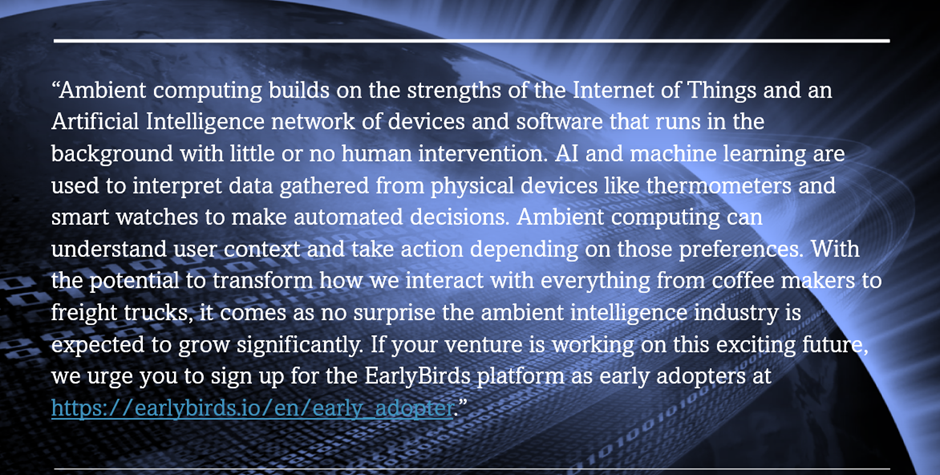Highlights
- EarlyBirds is bringing together innovators and experts to aid early adopters usher in the third wave of computing, ambient computing, to the masses.
- Ubiquitous computing is an assemblage of technologies operating together to take the next logical action in advance without user’s direct intervention.
- Today, development is being focused on the communication networks that are key to IoT to make them faster as well as more energy efficient.
- With EarlyBirds’ ecosystem maps, mature organisations can identify trends and gain a competitive advantage.
Open innovation ecosystem EarlyBirds is an dedicated to bringing together innovators and experts to allow early adopters usher in the third wave of computing, ambient computing, to the masses.
The ubiquitous computing is an assemblage of technologies operating together to take the next logical action in advance without user’s direct intervention. It was first devised by Mark Weiser, the head of Xerox’s PARC computer science library in early 1990s.
It refers to a vision of computing which fades off into the background, to let user maximise their time while the range of sensors and computing resources overpower the usual elements with smart automation.
According to the co-founder of EarlyBirds, Jeff Penrose, EarlyBirds is already here, by some definitions. He commented:

There are multiple technologies on which the businesses involved in developing ambient computing solutions depend upon, so as to deliver their final seamless output. In detecting user patterns that can be optimised, the IoT (Internet of Things) has marked a major place. This also requires strong hardware and sophisticated AI algorithms for their operation in the cloud, to crunch the generated data.
In the present day, the focus is on developing communication networks that are one of the major parts of IoT, such as Bluetooth, 5G, WiFi 6, and more to make them faster and more energy efficient.
The much popular personal assistant devices like Bixby, Siri, and Alexa get access to data enabling them to develop a better idea about the expectations of the users from smart appliances. These assistants can have more human-like interactions with new innovations in conversational AI powered by massive language models.
Here’s a remark by EarlyBirds’ co-founder Kris Poria on the advancement in technology:

The Australian OSINT platform with over 4.9 million innovators onboard can help industry leaders have an understanding of the new-age technological innovations in order to bring to effect the Mark Weiser’s vision of ubiquitous computing. With EarlyBirds’ ecosystem maps, mature organisations can identify trends and gain a competitive advantage.
The platform offers two programs, namely Explorer Program and Challenger Program. While the Explorer Program helps organisations with innovative solutions to level up their operations, or to undertake innovation projects, the Challenger Program has been drafted to resolve technical challenges and find out innovators to fulfil commercial, business and technical needs.
To know more about how startups working on technologies that form the ambient computing ecosystem can deliver an improved user experience, you may visit https://earlybirds.io/en/innovator.
More information about the Australian OSINT platform can be found at earlybirds.io.





